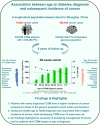Association Between Age at Diabetes Diagnosis and Subsequent Incidence of Cancer: A Longitudinal Population-Based Cohort
- PMID: 38237119
- PMCID: PMC10909688
- DOI: 10.2337/dc23-0386
Association Between Age at Diabetes Diagnosis and Subsequent Incidence of Cancer: A Longitudinal Population-Based Cohort
Abstract
Objective: Diabetes presenting at a younger age has a more aggressive nature. We aimed to explore the association of age at type 2 diabetes mellitus (T2DM) diagnosis with subsequent cancer incidence in a large Chinese population.
Research design and methods: The prospective population-based longitudinal cohort included 428,568 newly diagnosed T2DM patients from 2011 to 2018. Participants were divided into six groups according to their age at diagnosis: 20-54, 55-59, 60-64, 65-69, 70-74, and ≥75 years. The incidence of overall and 14 site-specific cancers was compared with the Shanghai general population including 100,649,346 person-years.
Results: A total of 18,853 and 582,643 overall cancer cases were recorded in the T2DM cohort and the general population. The age-standardized rate of overall cancer in T2DM patients was 501 (95% CI: 491, 511) per 100,000 person-years, and the standardized incidence ratio (SIR) was 1.10 (1.09, 1.12). Younger age at T2DM diagnosis was associated with higher incidence of overall and site-specific cancers. SIRs for overall cancer with T2DM diagnosis at ages 20-54, 55-59, 60-64, 65-69, 70-74, and ≥75 years were 1.48 (1.41, 1.54), 1.30 (1.25, 1.35), 1.19 (1.15, 1.23), 1.16 (1.12, 1.20), 1.06 (1.02, 1.10), and 0.86 (0.84, 0.89), respectively. Similar trends were observed for site-specific cancers, including respiratory, colorectum, stomach, liver, pancreatic, bladder, central nervous system, kidney, and gallbladder cancer and lymphoma among both males and females.
Conclusions: Our findings highlight the necessity of stratifying management for T2DM according to age of diagnosis. As with a range of vascular outcomes, age-standardized cancer risks are greater in earlier compared with later onset T2DM.
© 2024 by the American Diabetes Association.
Conflict of interest statement
Figures



Comment in
-
Diabetesdiagnose in jungem Alter erhöht das Krebsrisiko.MMW Fortschr Med. 2024 Nov;166(Suppl 3):14-16. doi: 10.1007/s15006-024-4415-0. MMW Fortschr Med. 2024. PMID: 39482510 Review. German. No abstract available.
References
-
- Magliano DJ, Sacre JW, Harding JL, Gregg EW, Zimmet PZ, Shaw JE. Young-onset type 2 diabetes mellitus - implications for morbidity and mortality. Nat Rev Endocrinol 2020;16:321–331 - PubMed
-
- Dev R, Bruera E, Dalal S. Insulin resistance and body composition in cancer patients. Ann Oncol 2018;29:ii18–ii26 - PubMed
MeSH terms
Grants and funding
LinkOut - more resources
Full Text Sources
Medical
Research Materials

